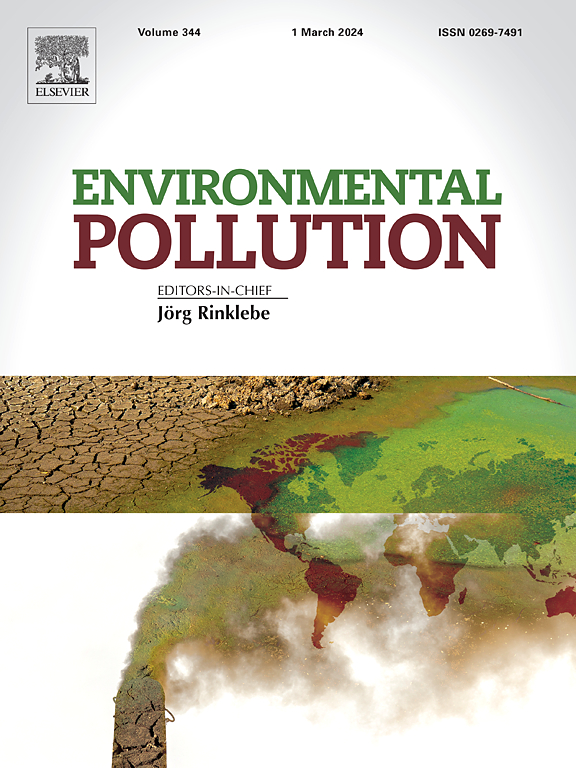以磷为补充指标的密松针评价土壤砷污染的短期评价
IF 7.6
2区 环境科学与生态学
Q1 ENVIRONMENTAL SCIENCES
引用次数: 0
摘要
废弃矿山释放砷,通过土壤-植物-人体接触途径对环境和健康构成严重风险。本研究评价了密松在土壤砷污染评价中的潜在作用,并评价了针叶中磷含量是否可以作为土壤砷污染评价的补充指标。在某矿山废坝上下游采集As浓度为33.71 ~ 3017.02 mg kg-1, pH值为4.90 ~ 8.55的土壤样品,进行一年生松树幼苗的培养,培养时间为6个月。分析了1年龄和2年龄针叶中As的积累规律,并分析了其与土壤中总As、olsen萃取As和Wenzel萃取As 1+2组分的关系。在土壤As组分中,olsen可提取As与针叶As浓度的相关性最强,尤其是2年树龄针叶As (r = 0.872, p <;0.001)。利用2年生针叶中磷含量和2年生针叶中砷浓度的多元回归模型,将模型的解释能力(R2)从0.761提高到0.828,赤池信息准则(AIC)从119.88降低到115.95,表明模型适应度增强。这些发现表明密植松针在土壤砷污染评价中的潜力,磷可以作为一个有价值的补充指标。本文章由计算机程序翻译,如有差异,请以英文原文为准。

Short-term evaluation for estimating soil arsenic contamination using Pinus densiflora needles with phosphorus as a supplementary indicator
Abandoned mines release arsenic (As), which poses severe environmental and health risks through soil–plant–human exposure pathways. This study evaluated the potential use of Pinus densiflora for estimating soil As contamination and assessed whether phosphorus (P) concentration in needles could serve as a supplementary indicator. Soil samples with 33.71–3017.02 mg kg−1 As concentrations and 4.90–8.55 pH were collected upstream and downstream of a mine waste dam, and first-year pine seedlings were cultivated for six months. The As accumulation patterns in 1- and 2-year-old needles were analyzed, and their relationships with soil As fractions, including total As, Olsen-extractable As, and fraction 1 + 2 of Wenzel extraction, were examined. Among the soil As fractions, Olsen-extractable As showed the strongest correlation with needle As concentrations, particularly in 2-year-old needles (r = 0.872, p < 0.001). A multiple regression model including P in 2-year-old needles to predict Olsen-extractable As, in addition to As concentration in 2-year-old needles, improved the model's explanatory power (R2) from 0.761 to 0.828 and decreased the Akaike information criterion (AIC) from 119.88 to 115.95, indicating enhanced model fitness. These findings demonstrate the potential of P. densiflora needles for soil As contamination assessment, with P serving as a valuable supplementary indicator.
求助全文
通过发布文献求助,成功后即可免费获取论文全文。
去求助
来源期刊

Environmental Pollution
环境科学-环境科学
CiteScore
16.00
自引率
6.70%
发文量
2082
审稿时长
2.9 months
期刊介绍:
Environmental Pollution is an international peer-reviewed journal that publishes high-quality research papers and review articles covering all aspects of environmental pollution and its impacts on ecosystems and human health.
Subject areas include, but are not limited to:
• Sources and occurrences of pollutants that are clearly defined and measured in environmental compartments, food and food-related items, and human bodies;
• Interlinks between contaminant exposure and biological, ecological, and human health effects, including those of climate change;
• Contaminants of emerging concerns (including but not limited to antibiotic resistant microorganisms or genes, microplastics/nanoplastics, electronic wastes, light, and noise) and/or their biological, ecological, or human health effects;
• Laboratory and field studies on the remediation/mitigation of environmental pollution via new techniques and with clear links to biological, ecological, or human health effects;
• Modeling of pollution processes, patterns, or trends that is of clear environmental and/or human health interest;
• New techniques that measure and examine environmental occurrences, transport, behavior, and effects of pollutants within the environment or the laboratory, provided that they can be clearly used to address problems within regional or global environmental compartments.
 求助内容:
求助内容: 应助结果提醒方式:
应助结果提醒方式:


